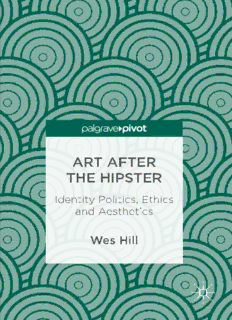
Art after the Hipster: Identity Politics, Ethics and Aesthetics PDF
Preview Art after the Hipster: Identity Politics, Ethics and Aesthetics
ART AFTER THE HIPSTER Identity Politics, Ethics and Aesthetics Wes Hill Art after the Hipster DarrenSylvester,WhatHappensWillHappen(2012) Wes Hill Art after the Hipster Identity Politics, Ethics and Aesthetics WesHill SchoolofArtsandSocialSciences SouthernCrossUniversity Lismore,NewSouthWales Australia ISBN978-3-319-68577-9 ISBN978-3-319-68578-6 (eBook) https://doi.org/10.1007/978-3-319-68578-6 LibraryofCongressControlNumber:2017954497 ©TheEditor(s)(ifapplicable)andTheAuthor(s)2017 Thisworkissubjecttocopyright.AllrightsaresolelyandexclusivelylicensedbythePublisher, whetherthewholeorpartofthematerialisconcerned,specificallytherightsoftranslation, reprinting,reuseofillustrations,recitation,broadcasting,reproductiononmicrofilmsorinany otherphysicalway,andtransmissionorinformationstorageandretrieval,electronicadaptation, computersoftware,orbysimilarordissimilarmethodologynowknownorhereafterdeveloped. Theuseofgeneraldescriptivenames,registerednames,trademarks,servicemarks,etc.inthis publicationdoesnotimply,evenintheabsenceofaspecificstatement,thatsuchnamesare exemptfromtherelevantprotectivelawsandregulationsandthereforefreeforgeneraluse. Thepublisher,theauthorsandtheeditorsaresafetoassumethattheadviceandinformationin thisbookarebelievedtobetrueandaccurateatthedateofpublication.Neitherthepublisher northeauthorsortheeditorsgiveawarranty,expressorimplied,withrespecttothematerial contained herein or for any errors or omissions that may have been made. The publisher remains neutral with regard to jurisdictional claims in published maps and institutional affiliations. Coverillustration:MonoCircles©JohnRawsterne/patternhead.com Printedonacid-freepaper ThisPalgraveMacmillanimprintispublishedbySpringerNature TheregisteredcompanyisSpringerInternationalPublishingAG Theregisteredcompanyaddressis:Gewerbestrasse11,6330Cham,Switzerland P REFACE Evoking a level of animosity from a bygone cultural moment, the hipster belongstoatimewhentheeconomicadvantagesofculturalinnovationin the arts were seriously believed. What that time was, and where we are now, is this book’s subject, examined through the lens of art history and the creativity hype of neoliberalism. Having been associated with post- WorldWarTwobebopandbeatniksubcultures,thehipsterre-emergedin the early 2000s as a form of generic individualism that was easily identifi- able even if endlessly mutable. However, in recent years “hipster” has become increasingly impotent as an accusation, shifting in its meaning to refer less to an external identity than to a mode of deflection in which authenticity and discernment are challenged only to be surreptitiously reinforced. Marking a transition from a period in Western art when irony and high-minded nonchalance reigned, the hipster appears in the context of contemporary art not as a critical standpoint in itself but as the contin- ually deferred subject position of creative practice. Today, ethical consid- erations of identity overshadow discerning proclamations of cultural taste, makingpalpableanuncertaintyaboutourcapacitytountanglecapitalism’s thirst for reinvention from the artist’s thirst for subverting norms. WesHill v C ONTENTS 1 Introduction:CaringTooMuchandNotEnough 1 2 TheTwenty-First-CenturyHipster 9 ArtyPluralism 9 IstheHipsterReallyDead? 11 HipsterPrivilege 12 HipsterHate 13 TheHipsterasaGlobalContemporaryPhenomenon 15 SlipperyHipster 18 Post-critical:LivingwithHypocrisies 22 Žižek’sHipsterOther 27 Rancière’sHipster:DissensusasConsensus 29 Rancière’sTheoryofAesthetics 31 PoliticsandEthics 34 TheHipsterasaProductoftheMiddleClasses 38 3 ThePostmodernHipster 47 HipsterOrigins 47 Broyard’sHipster:TheInauthenticityofBeingBlack 50 HipsterInfrapolitics 54 AestheticRivalries 57 ThePitfallsofHipsterCritique 60 vii viii CONTENTS Baudrillard’sHipsterasPostmodernConsumer 63 PostmodernCritiqueasNihilisticRevelation 65 DandiesandFla^neurs:TheOriginalHipsterIronists 68 WarholasProto-Hipster 70 Duchamp’sIronicKnowingness 73 HipsterIronyasAestheticFeeling:DeDuveonDuchamp 75 TheHipster’sSocialWithdrawalasSocialConnection 77 PasticheasPejorativePostmodernism 80 4 TheHipsterasanEntrepreneuroftheSelf 91 TheMarketLogicofNeoliberalism 91 1990sAlternativeCultureasProto-Hipsterism 93 TheSelf-SabotageoftheAlternative 95 TheArtyAlternativeoftheYBAs 96 CreativityasaToolofGentrification 98 Foucault’sEntrepreneuroftheSelf 100 ActivismWithoutCollectivity 103 ConscientiousCapitalism:Bourriaud’sRelationalAesthetics 107 HipsterUtopias 109 CombattingSameness:CuratingSubalternSubjectivities 111 CounteringCreativitywithInertia 114 Groys:FabricatingArtisticAuthenticity 117 GlobalArtUnderNeoliberalConditions 122 5 Conclusion 129 Bibliography 135 Index 145 CHAPTER1 Introduction: Caring Too Much and Not Enough Abstract In this section, the concept of the hipster is introduced as an endlesslymutablesetof“arty”codesandasanutterance;aparadoxicalact ofdenouncingculturaldiscernmentonlytosurreptitiouslyreinforceit. Keywords Hipster(cid:129)Taste(cid:129)Cosmopolitan(cid:129)Egalitarianism(cid:129)Paradox Anyone who has ever attempted to seriously think about the hipster as a concept will be aware of how challenging it is to define, let alone to place intoclearframesofreference.Thisisbecausetherearen’tmanypeoplewho want to be labelled “hipster.” The word is overwhelmingly used as a pejorative, and, as an admonition, it is peculiarly vague in its malleability, capableofdescribingcreativeswhocaretoomuchornotenough;whoexist inside or outside of the dominant social order; who represent stylized yet anti-aesthetic ideals and who try to improve the social bond even while promotingsocialdistinctions.Whenthehomogenousstylingsofasuppos- edlycreativetropearemadeclear,itisnaturaltowonder:howdidwegetto thispointwheretheartyandthegenericco-exist? In the early 2000s, “hipster” emerged in the parlance of capitalist soci- eties around the world, shifting beyond its original jazz and beatnik con- notations to serve as a pejorative term for neoliberal taste. While the “progressive” tastes of urban white Western males were ingrained in the original hipster stereotype, over the course of the 2000s it came to ©TheAuthor(s)2017 1 W.Hill,ArtaftertheHipster, https://doi.org/10.1007/978-3-319-68578-6_1 2 1 INTRODUCTION:CARINGTOOMUCHANDNOTENOUGH encompassdifferentgendersandculturalbackgrounds,urbanandregional settings, and entrepreneurs and luddites alike. Giving a new edge to the Anglo-American and Western-European varieties of postmodernism, the hipster traded postmodern cynicism for a bathetic form of cosmopolitan egalitarianism. When it was at its peak, “hipster” conveyed the speed and ease with whichnicheideasandcommoditiesaredispersed(anddismissed)intheage oftheInternet,mostconspicuouslyintheareasofartandcraft,alternative culture (especially music) and vernacular fashion. However, at least since 2015,“hipster”hasbeenlosingitscurrency,inspiteofitsbeingimplicated inhothousedebatessurroundinggentrification,culturalappropriationand identity politics. Hipsters obviously remain recognizable in mass culture, subcultures and “alternative subcultures” the world over—whatever these termsactuallymeannow—buttheyarenolongersocompulsivelylabelled, andthestereotypenowseemsboundtoamomentthathaspassed.Attrib- utedmostlytomillennials,butalsotoanyoneundertheageofabout50,the stereotypenowservesasasymboloftheaffectatiousandaspirationalterrain onwhichdigitalculturewasestablished. From the time that Internet memes first became a phenomenon in the mid-2000s, artist memes and hipster memes have looked almost identical. Bothcaricaturepeoplewhoaredesperatetobedistinctive,culturallyliterate, ethically advanced or known for discovering some obscure phenomenon before anyone else. The contemporary hipster is, of course, an update of the bebop hipster, which was defined in Anatole Broyard’s 1948 essay as a posture of “indefinable authority,” resembling a form of cultural one-upmanshipthatoccupiesavernacularcriticalspace,reducingtheworld to “schematic proportions.”1 Entailing those who are smugly in-the-know andwhoclaimtobeoneofthosecoolfolkswho“getit”in-advance,Broyard aptly used the term “priorism” to describe the African-American hipster’s pretentiousposeofaprioriknowledge.2Inthetwenty-firstcentury,thistrope that was once exclusive to African-American identity morphed, long after NormanMailer’s“whitenegro,”intothestereotypeofliberal,neoliberaland left-wing arty status. It led to “hipster” becoming linked to an enormous rangeofculturalthings:craftbeer,vintagefloraldresses,burgersinbrioche buns,cocktailsinjarsaswellascreativepersonificationssuchasDJ,filmbuff, artcritic,curatorandartist,allofwhichembodyan“arty”sensibility. I use the term “arty” to describe the hipster’s affectatious appearance and to signal egalitarianism-as-aesthetics, as in Hal Fos- ter’s 2003 description of relational aesthetics as an “arty party.”
Description: